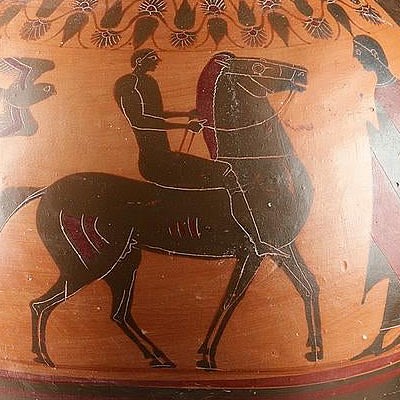Olmec Green Stone Amulet / Pendant
Lot 131
About Seller
Artemis Gallery
686 S Taylor Ave, Ste 106
Louisville, CO 80027
United States
Selling antiquities, ancient and ethnographic art online since 1993, Artemis Gallery specializes in Classical Antiquities (Egyptian, Greek, Roman, Near Eastern), Asian, Pre-Columbian, African / Tribal / Oceanographic art. Our extensive inventory includes pottery, stone, metal, wood, glass and textil...Read more
Estimate:
$1,800 - $2,500
Absentee vs Live bid
Two ways to bid:
- Leave a max absentee bid and the platform will bid on your behalf up to your maximum bid during the live auction.
- Bid live during the auction and your bids will be submitted real-time to the auctioneer.
Bid Increments
| Price | Bid Increment |
|---|---|
| $0 | $25 |
| $300 | $50 |
| $1,000 | $100 |
| $2,000 | $250 |
| $5,000 | $500 |
| $10,000 | $1,000 |
| $20,000 | $2,500 |
| $50,000 | $5,000 |
| $100,000 | $10,000 |
| $200,000 | $20,000 |
About Auction
By Artemis Gallery
Jun 4, 2020
Set Reminder
2020-06-04 10:00:00
2020-06-04 10:00:00
America/New_York
Bidsquare
Bidsquare : Exceptional Antiquities, Asian, Ethnographic
https://www.bidsquare.com/auctions/artemis-gallery/exceptional-antiquities-asian-ethnographic-5185
An important one-day auction featuring museum-worthy examples of Egyptian, Greek, Roman, Etruscan, Near Eastern, Far East / Asian, Pre-Columbian, African / Tribal, Oceanic, Native American, Spanish Colonial, Russian, Fossils, Ancient Jewelry, Fine Art, so much more! Artemis Gallery info@artemisgallery.com
An important one-day auction featuring museum-worthy examples of Egyptian, Greek, Roman, Etruscan, Near Eastern, Far East / Asian, Pre-Columbian, African / Tribal, Oceanic, Native American, Spanish Colonial, Russian, Fossils, Ancient Jewelry, Fine Art, so much more! Artemis Gallery info@artemisgallery.com
- Lot Description
Pre-Columbian, Southern Mexico to Guatemala, Olmec, ca. 500 to 200 BCE. A striking Olmec pendant, finely carved with an expressive visage from a beautiful greenstone of soothing verdant hues. The face presents characteristic Olmec features such as slit form eyes with nice partial piercing at either end, a broad nose with delineated nostrils, and a down-turned mouth with a visible tongue or cleft. A special example from the Olmec, generally regarded as the first Mesoamerican civilization that was admired by the later Maya and Aztec civilizations. Perhaps referring to a nature spirit or deity, this amulet was likely intended for an elite individual of import, perhaps to protect against evil. Impressively carved and string-cut to bring this stone to life, the amulet is perforated above and beside the temples for suspension, these perforations now used to display on the custom stand. Size: 2.5" W x 1.35" H (6.4 cm x 3.4 cm); 1.6" H (4.1 cm) on included custom stand.
We know that the Olmec settled in areas including San Lorenzo Tenochtitlan, La Venta, Tres Zapotes, Laguna de los Cerros, and La Mojarra; however, their influence impacted the entire Mesoamerican region. In 2005, Neutron Activation Analysis and petrography was used to demonstrate this impact via the widespread existence of Olmec ceramic vessels. Scholars suspect that other groups equated the Olmec style with elite status given the exchange and emulation of Olmec artifacts throughout Mesoamerica. It is also believed that the Olmec invented the famous Mesoamerican ballgame prevalent among the later Maya as well as other cultures in the region, and may have also invented religious entities such as the feathered serpent and the rain god, which would continue in subsequent cultures.
While difficult to completely understand their belief system given that the Olmec were pre-literate, scholars theorize that their famous monumental stone heads, which can weigh up to forty tons, may have been erected to honor ancestors or rulers. The smaller greenstone figures and amulets like this example are thought to represent totems or divinities. The artistry and technique of Olmec sculptural works is remarkable given what little technology that was available to them as well as the dearth of earlier works to reference for inspiration. The Olmec style oftentimes embraces a certain amount of naturalism as well as abstract interpretation of particular facial features - i.e. down- turned mouths and slit eyes - as we see on this amulet.
Provenance: ex-Barakat Gallery, Beverly Hills, California, USA, acquired prior to 2000
All items legal to buy/sell under U.S. Statute covering cultural patrimony Code 2600, CHAPTER 14, and are guaranteed to be as described or your money back.
A Certificate of Authenticity will accompany all winning bids.
We ship worldwide and handle all shipping in-house for your convenience.
#155904Intact. The stone has a weathered surface with some abrasions, but the features are well preserved and clear.Condition
- Shipping Info
-
All shipping is handled in-house for your convenience. Your invoice from Artemis Gallery will include shipping calculation instructions. If in doubt, please inquire BEFORE bidding for estimated shipping costs for individual items.
-
- Buyer's Premium



 EUR
EUR CAD
CAD AUD
AUD GBP
GBP MXN
MXN HKD
HKD CNY
CNY MYR
MYR SEK
SEK SGD
SGD CHF
CHF THB
THB














